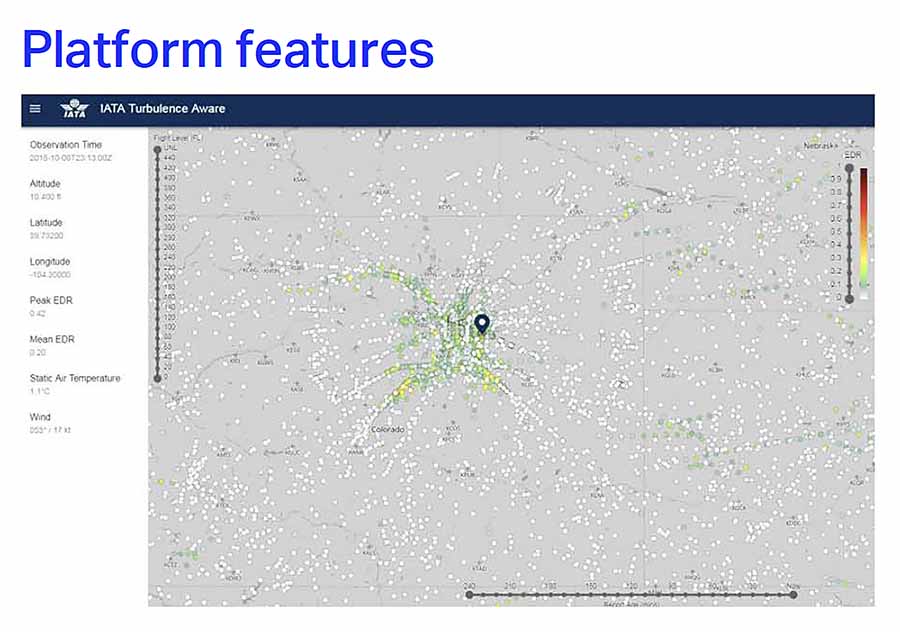
Turbulence presents a significant safety concern for the airline industry, resulting in major financial costs every year. It is a leading cause of injuries in-flight and is the primary cause of injuries in non-fatal accidents, as reported by the FAA. The economic impact of turbulence includes potential in-flight diversions due to injuries, damage to aircraft interiors, excessive fuel burn, and increased CO2 emissions.
Several airlines currently use turbulence reporting products, but they typically focus solely on turbulence within their own airline, leaving gaps in coverage for pilots and dispatchers. This lack of comprehensive data can make it challenging to plan and navigate around turbulent areas.
To address this issue in the mid 2010s, airlines requested that International Air Transport Association (IATA) act as a global data consolidator. By having multiple airlines contribute their turbulence data to a shared database, the industry will gain the ability to access turbulence reports from various carriers, ultimately enhancing turbulence mitigation efforts.
Current aviation meteorological tools have limitations. Reports are subjective and can vary depending on aircraft size and pilot experience. Forecasts may be outdated and potentially inaccurate. The existing tools for managing turbulence, such as subjective pilot reports and outdated forecasts, are not always effective. While weather radar is useful for avoiding turbulence linked to thunderstorms, it cannot detect clear air turbulence.
How turbulence data works
Advancements in technology now allow aircraft to accurately calculate the turbulence state of the atmosphere during flight. Airlines utilise existing sensor data, which is processed through an algorithm to determine turbulence values. These values are compiled into a detailed report that includes a time stamp, aircraft position, and altitude. Automated real-time turbulence reports are then transmitted to the ground via standard aircraft communication systems.
One example of how real-time turbulence data is beneficial was seen in Delta Air Lines’ operational data use. By relying on real-time turbulence data, a captain was able to secure the cabin despite a smooth ride report from air traffic control. The aircraft later encountered moderate turbulence, which resulted in items being tossed around the cabin, but no injuries to passengers or cabin crew occurred. This illustrates how utilizing real-time turbulence data can help pilots make better decisions and ultimately reduce the number of injuries.
Due to these advancements and benefits, airlines requested IATA to act as a global data consolidator, to improve the sharing and utilisation of turbulence data across the industry. Launching the programme, the Turbulence Aware Viewer, in 2019, Wilie Walsh, CEO of IATA said: Turbulence is a significant cause of injuries to cabin crew and passengers in non-fatal accidents. It not only instills fear and uncertainty in many air travellers but also costs airlines millions of dollars annually and damages their brand reputation.
Aer Lingus was one of 14 airlines that helped establish this platform. IATA partnered with Snowflake software, an English-based company specializing in real-time aviation data fusion, to develop the first global turbulence data sharing platform. This platform not only processes and hosts turbulence data from different airlines but also allows them to incorporate it into their existing flight planning and in-flight tools used by operations control centre personnel and pilots. The global data is visually presented on the IATA Turbulence Aware web-based viewer.
More airlines, more data
Data is collected in real-time from airlines or third-party ground servers, then processed, quality controlled, and anonymized within 30 seconds. Airlines can integrate this data into their flight planning and in-flight tools. The IATA Turbulence Aware platform serves as a global solution for sharing automated turbulence reports in real-time.
The platform gathers anonymised turbulence data from thousands of flights conducted by participating airlines. This real-time and accurate information empowers pilots and dispatchers to select the most optimal flight paths, avoiding turbulence and flying at the best levels to enhance fuel efficiency and reduce CO2 carbon emissions. The software, developed by the National Centre of Atmospheric Research (NCAR), is integrated into the avionics system of the aircraft. Some of the newer aircraft models, like the Airbus A350, Boeing 737 MAX, and Boeing 787, come with this software pre-installed. Airlines also have the option to implement this software in-house if they possess the technical capabilities. The long-term success of the program relies on having a large number of active data points shared, ensuring compatibility with the airline’s existing technology framework.
The Turbulence Aware Viewer provides a snapshot of the platform’s features. Turbulence reports are color-coded and displayed on a map, with white dots indicating areas of no turbulence and colored dots showing different intensity levels of turbulence based on the scale provided. Users can filter turbulence reports by flight level on the left side of the viewer and use the time slider at the bottom to view reports from the present moment up to four hours prior. Clicking on a dot allows users to access detailed reports, including information on time, altitude, aircraft position, mean and peak turbulence values, as well as wind and temperature data.
Research conducted by Paul Williams at the University of Reading suggests that the rate of turbulence is projected to increase by 149pc in the coming years. Not only will turbulence become more frequent, but it will also become more severe and impactful in its scale. This emphasizes the importance of the aviation industry adopting advanced tools to measure, report, and navigate these evolving environments, ensuring safe and efficient air travel for all stakeholders.
The University of Reading’s findings indicate that severe and moderate-to-severe turbulence is expected to more than double due to anticipated rises in carbon dioxide levels in the atmosphere. The research, published in the journal Advances in Atmospheric Sciences, utilized supercomputer simulations to examine how turbulence will alter at 39,000 feet when carbon dioxide levels double. Dr. Paul Williams, the author of the study, stated that this carbon dioxide level increase is anticipated by the end of the century. Williams’ research shows that severe turbulence is estimated to increase by 149%, moderate-to-severe turbulence by 127%, light-to-moderate turbulence by 75%, and light turbulence by 59%. The impact of climate change is reinforcing wind shears, which are significant triggers of turbulence.
More information for pilots
By developing Turbulence Aware, IATA offers airlines more precise and practical information to address turbulence-related challenges on all flights.
In situations where pilots are aware of turbulence during a flight, there are proactive measures they can take. If turbulence is observed on an aircraft ahead, the pilot can secure the cabin effectively to reduce the risk of passenger injury. Moreover, if there is sufficient time, the pilot can request a different altitude or heading to avoid turbulence. Accurate readings of turbulence during a flight allow pilots and dispatchers to make more informed decisions about flight paths and safety procedures.
Apart from enhancing safety and passenger comfort, a real-time turbulence report during a flight offers various benefits. The data gathered by Turbulence Aware is valuable for refining Standard Operating Procedures (SOPs) to enhance fuel efficiency. In addition to turbulence information, Turbulence Aware provides various parameters, enabling pilots to make informed choices about adjusting flight levels along their route to maximize fuel efficiency.
There is a critical need for improved tools to measure turbulence. Subjective turbulence reports can lead to confusion and misinformation. A pilot’s assessment of turbulence may vary based on their experience, personality, and the type of aircraft they are operating. For instance, a pilot flying a King Air aircraft may not perceive any turbulence. Another pilot form Queen air will identify it as a potential problem.
How the EDR works
The Eddy Dissipation Rate (EDR) is recognized as the most effective method for measuring turbulence. EDR quantifies the atmospheric conditions surrounding an aircraft in flight. This measurement can be obtained by installing straightforward software that collects real-time data and promptly reports that information.
Parameters for EDR include the Observation Time (time of report in UTC), Altitude (altitude above sea level in feet), Latitude (geographical coordinate for latitude), Longitude (geographical coordinate for longitude), Peak EDR (maximum EDR value in the calculation), Mean EDR (average EDR value of the calculation), Wind Speed (in knots), Wind Direction (in radial), and Static Air Temperature (in degrees celsius).
The EDR algorithm uses atmospheric and aircraft data to compute turbulence values. Many aircraft already have EDR capabilities, but for those that do not, a simple software installation suffices to acquire these measurements without the need for additional hardware.
Implementing EDR turbulence reporting capabilities can be done cost-effectively. IATA supports a free open-source EDR algorithm developed by the National Center of Atmospheric Research (NCAR). Airlines have the option to conduct an in-house EDR implementation with the assistance of IATA’s free support, or they can opt to pay an implementation fee to a third party.
Turbulence Aware is a global platform designed for sharing automated EDR turbulence reports in a matter of seconds. In-flight, flight parameters are collected by ACMS and processed through the NCAR v2 algorithm to generate an EDR report. This report is then sent to the airline server and the IATA Platform, where the data is disseminated instantly to the IATA MET Viewer or other third-party integrators. Pilots and air traffic controllers can access real-time turbulence data to plan and adjust flight patterns for optimal safety and efficiency.
To view the data, pilots and dispatchers can utilize the MET Viewer, accessing it through an internet connection or another in-house method. Airlines also have the option to involve a third party as an authorized agent to integrate the data back into an in-house platform for pilot and dispatcher access.
How the MET Viewer works
The MET Viewer, the platform created by IATA to showcase turbulence reports generated by Turbulence Aware, provides detailed turbulence reports, location information, integrates flight plans, and displays the trajectory of observed turbulence reports.
Although your airline may already utilise dispatch and flight deck tools for viewing various weather data, Turbulence Aware offers the most accurate real-time turbulence data available. This user-friendly tool can be overlaid onto your existing suite of tools or fully integrated into your system, providing flexibility to operationalize the data as needed. Turbulence Aware offers valuable insights to help you make better decisions regarding flight paths before and during a flight, optimizing safety and comfort for both passengers and staff.
The cost benefits of utilizing Turbulence Aware are significant. Market research indicates that turbulence can cost airlines anywhere from $250K to $2m per year. By leveraging Turbulence Aware, airlines can strategically and adaptively address turbulence issues, avoiding unnecessary and costly damages to aircraft, crew, and passengers alike.
Currently, over 17 airlines are using Turbulence Aware and contributing data to this open-source platform. Airlines such as Qatar Airways, Qantas, and Southwest Airlines rely on Turbulence Aware to ensure smoother and safer flights for their customers and crew. Additionally, Turbulence Aware is suitable for Air Navigation Service Providers (ANSPs), Original Equipment Manufacturers (OEMs), Meteorological Organizations, Business Aviation, and data integrators. Users appreciate Turbulence Aware for its ease of use and provision of detailed data to enhance flight safety and performance.
Utilising Turbulence Aware eliminates the need to rely on subjective information. The platform offers extraordinarily accurate real-time data to support better decision-making for smoother and safer flights. By avoiding the costly repercussions of turbulence, flights can become more enjoyable for both passengers and crew members.



